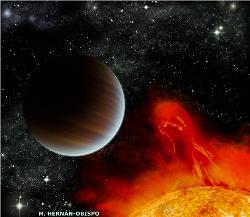Feb 19 2010
University of Hertfordshire astronomers, Dr Maria Cruz Gálvez-Ortiz and Dr John Barnes, are part of an international collaboration that has discovered the youngest extra-solar planet around a solar-type star, named BD+20 1790b.
 BD+20 1790b
BD+20 1790b
The giant planet, six-times the mass of Jupiter, is only 35 million years old. It orbits a young active central star at a distance closer than Mercury orbits the Sun. Young stars are usually excluded from planet searches because they have intense magnetic fields that generate a range of phenomena known collectively as stellar activity, including flares and spots. This activity can mimic the presence of a companion and so can make extremely difficult to disentangle the signals of planets and activity.
Dr Maria Cruz Gálvez-Ortiz describing how the planet was discovered said: “The planet was detected by searching for very small variations in the velocity of the host star, caused by the gravitational tug of the planet as it orbits – the so-called “Doppler wobble technique”. Overcoming the interference caused by the activity was a major challenge for the team, but with enough data from an array of large telescopes the planet’s signature was revealed.”
There is currently a severe lack of knowledge about early stages of planet evolution. Most planet-search surveys tend to target much older stars, with ages in excess of a billion years. Only one young planet, with an age of 100 million years, was previously known. However, at only 35 million years, BD+20 1790b is approximately three times younger. The detection of young planets will allow the testing of formation scenarios and to investigate the early stages of planetary evolution.
BD+20 1790b was discovered using observations made at different telescopes, including the Observatorio de Calar Alto (Almería, Spain) and the Observatorio del Roque de los Muchachos (La Palma, Spain) over the last five years. The discovery team is an international collaboration including: M.M. Hernán Obispo, E. De Castro and M. Cornide (Universidad Complutense de Madrid, Spain), M.C. Gálvez-Ortiz and J.R. Barnes, (University of Hertfordshire, U.K.), G. Anglada-Escudé (Carnegie Institution of Washington, USA) and S.R. Kane (NASA Exoplanet Institute, Caltech, USA). The discovery has just been published in the Astronomy & Astrophysics journal.